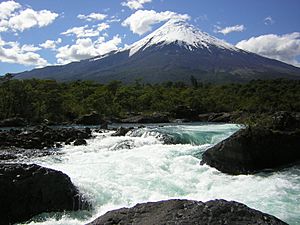Petrohué Waterfalls facts for kids
The Petrohué Waterfalls (pronounced petro-WEH), also known as Saltos del Petrohué in Spanish, are amazing waterfalls in Chile! They are found on the Petrohué River, not far from where the river starts at Todos los Santos Lake. These beautiful falls are inside a special place called Vicente Pérez Rosales National Park. Many tourists stop here to enjoy the incredible views, especially those traveling between Puerto Montt in Chile and Bariloche in Argentina.

Contents
Discover the Petrohué Waterfalls
The Petrohué Waterfalls are a type of waterfall called a "chute." This means the water flows very fast down a narrow, steep channel. The waterfalls are supported by hard, dark rocks that came from the Osorno Volcano. This volcano sits between Todos los Santos Lake and Llanquihue Lake, and it makes a fantastic background for photos!
How the Waterfalls Formed
The rocks that form the waterfalls are made of cooled lava from the Osorno Volcano. This type of lava is called basaltic lava or andesite. Over a very long time, the powerful water of the Petrohué River has carved and polished these volcanic rocks. This is why the rocks look so smooth and shiny!
Water Flow and Color
On average, about 270 cubic meters of water flow over these falls every second. That's a huge amount of water, like filling 270 large bathtubs every second! During the rainy season, even more water flows, and the level of Todos los Santos Lake can rise by up to 3 meters.
Usually, the water in the falls is very clear and has a beautiful green color. This is because the lake acts like a giant filter, letting sand and dirt settle to the bottom. However, sometimes, if there are "lahars" (mudflows from the volcano) happening, the water can become cloudy with sand and silt.
Animals You Might See
If you visit the Petrohué Waterfalls and look closely, you might spot some special birds called torrent ducks. These ducks are super skilled at swimming and diving in fast-moving water, even in the rapids of the falls! If you visit during the right season, you might even see them with their little ducklings.
See also
 In Spanish: Saltos de Petrohué para niños
In Spanish: Saltos de Petrohué para niños

